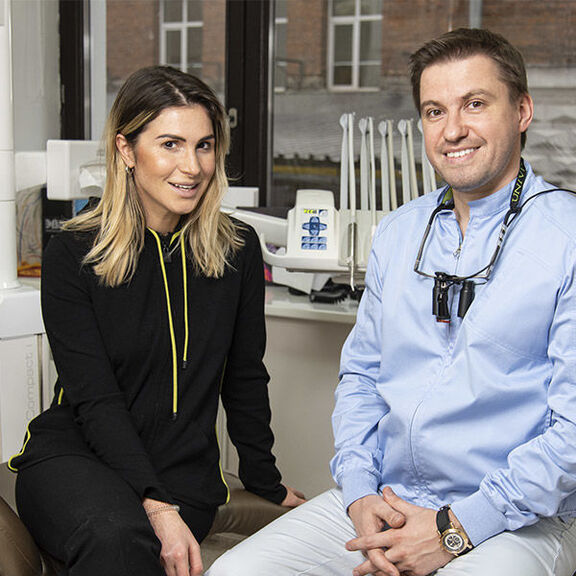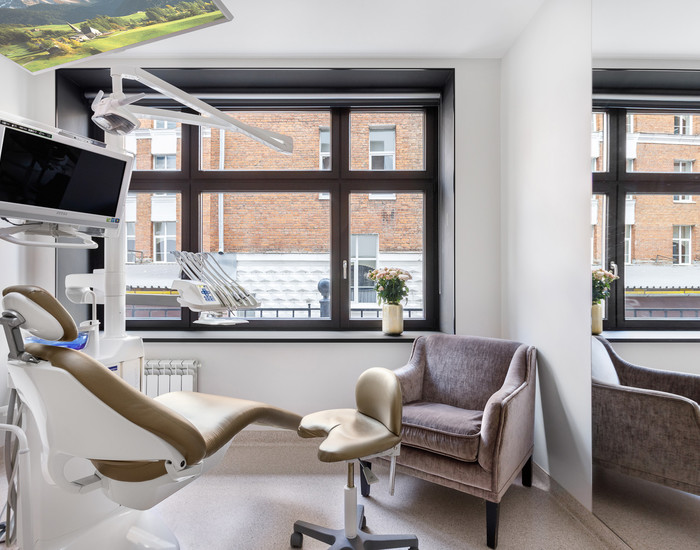Many dental diseases require endodontic treatment, that is, treatment of the tooth's root canals. Inside them is the pulp—a soft fibrous structure penetrated by nerve endings and blood vessels. It can become inflamed, and in this case, it will be necessary to remove the inflammation or even remove it altogether. However, there may be situations when root canal re-treatment is required. We explain when this is necessary and what the doctor does to help the patient without pain and discomfort.
How we can be
useful to you:
Veneers Without Grinding
Pediatric dentistry
Correction of bite
Implantation and crowns
Causes
Re-treatment of canals is required due to medical error or due to objective circumstances.
Doctors' errors arise from insufficient qualification, inattentiveness, non-compliance with protocols. Employees of the AESTHETE dental clinic do not allow this, but it is necessary to know what consequences may arise when turning to unscrupulous dentists:
inaccurate diagnosis, incorrectly composed treatment plan;
insufficient disinfection of cavities inside the tooth;
- poor-quality filling, due to which pathogenic microorganisms penetrated the canals;
- root perforation;
- fracture of the dental instrument, after which fragments remained in the canal;
- poor-quality restoration of the crown part.
- Objective circumstances that do not depend on doctors include:
- repeated penetration of infection from periodontal tissues;
- presence of additional root canals that could not be detected during initial diagnostics and previous treatment;
- deterioration of the condition of a long-standing filling.
In which cases can canals be re-treated?
Indications for repeat endodontic treatment are:
- the occurrence of pain in a recently treated tooth;
- detection of pathological changes on an X-ray— it may be made for another reason, but problems will still be noticeable.
Canal revision is carried out before prosthetics, when installing inlays, posts. This needs to be done because problems at the root will not disappear on their own. They will develop, inflammation will begin, and it will be necessary to remove the crown. At the same time, it will still be necessary to deobstruct the root canals and re-treat them.
In this case, it is necessary to consider contraindications, which can be relative and absolute.
Relative:
- unsatisfactory oral hygiene—treatment can be resumed after getting rid of caries, pulpitis, eliminating foci of inflammation;
- exacerbation of systemic diseases—treatment is continued after improving the patient's health condition;
- difficult access to the working area—the problem is solved on an individual basis.
Absolute contraindications—those that make re-treatment impossible. This category includes:
- significant destruction of the tooth;
- vertical root fracture;
- unfavorable prognosis regarding the damaged tooth;
- individual intolerance to the agents used for anesthesia;
- nervous, mental disorders, due to which the patient is unable to adequately respond to the dentist's actions.
Re-Root Canal Treatment
-
Title
Price
-
Re-Root Canal Treatment
from 3 190 AED
Effectiveness
The quality of repeat root canal treatment is assessed by the doctor during a repeat visit. Usually, the dentist schedules control visits. The patient needs to come to the clinic according to this schedule so that the doctor can make sure that everything is alright. If there are problems, he will detect them in time and suggest a further treatment tactic.
Typically, control examinations are scheduled six months after re-treatment. If the case was complex, additional examinations may be required after a year and after 24 months. X-ray control is mandatory.
Signs of successful repeat endodontic treatment:
- the absence of any unpleasant sensations in the area of the tooth whose root canals were treated;
- bone tissue regeneration, which is observed 6-12 months after the dentist's work is completed;
- natural color, normal texture of tissues next to the re-treated tooth 12 months after medical manipulations;
- no pathological changes in the periapical areas.
Advantages of re-treatment under a microscope
Endodontic treatment will be more successful if it is conducted under a dental microscope. This is a special optical device designed for dentists. Now doctors use electronic microscopes, which allow displaying the image on a screen. Because of this, it is possible to:
- visually enlarge the area in which the doctor performs manipulations, examine it in the smallest details, unmistakably determine the structure of the canals in the tooth roots, their diameter, shape;
- provide lighting for hard-to-reach areas;
- treat only those places where there are pathological changes, without affecting healthy tissues;
- transmit the image to an assistant or colleagues who will help carry out the repeat treatment of the canals;
- work in a comfortable position, not strain the eyes, not hover over the patient, which causes him discomfort;
- record the process on video in digital format—this allows you to review the clip in the future, assess the doctor's work, make sure that it is done correctly, or detect errors.
How is canal re-treatment carried out?
Repeat endodontic treatment—a set of medical manipulations that are performed in this sequence.
- The doctor opens the canal, carefully removes the filling material from it.
- Then the dentist examines the resulting cavity, assesses its condition.
- At the next stage, it is necessary to treat the canals. The doctor passes them to the end, to completely eliminate the focus of pathology, not allowing its further development.
- The final stage of treatment—repeat filling. It is important to do the work so that another re-treatment is not needed.
The treatment will be successful if it is conducted by an experienced dentist, who has the necessary tools and high-quality filling materials at his disposal. It is better if he performs the work under a dental microscope.
Usually, two visits are required for re-treatment. First, the canals are treated, then medications for disinfection are introduced into them, after which a temporary filling is installed. During the second visit, the doctor assesses the condition of the tooth and, if everything is in order, places a permanent filling, restores the crown part of the tooth.
How is root canal treatment carried out?
For cleaning the canals, dentists use special equipment and tools. First of all, these are apex locators, endodontic motors, drills, disposable needles. The tools are made of nickel-titanium alloy, other similar materials, which are characterized by light weight, strength, hypoallergenicity. The purpose of the treatment is to remove the old filling material, remove pathogenic microorganisms from the canal.
Additionally, doctors use medicinal products. They are also effective against pathogenic bacteria.
The situation becomes more serious if the patient's root system is complex, branched, the canals have a tortuous structure, sharply bend. For effective treatment, dentists use intracanal electrophoresis, transcanal ultraphonophoresis. Cleaning will give a better result if the medical approach is comprehensive, considering different methods of impact.
To make you healthy,
happy and successful!
will help you with this
What to do if the canals cannot be re-treated?
During treatment, the dentist tries not only to solve the problem but also to save the tooth. Unfortunately, this is not always possible.
If it is not possible to perform repeat endodontic treatment, doctors use surgical methods. A common solution is the complete or partial removal of the affected root while preserving the crown part. But in some cases, it may be necessary to remove the crown, which is replaced with a prosthesis.
In complex, advanced cases, it will be necessary to remove the tooth. To avoid this, it is advisable to see a dentist as soon as possible if you feel pain or other unpleasant symptoms.
After removing the tooth unit, it is necessary to restore it to prevent atrophy of the jawbone due to the absence of load. The best solution is implantation. If for some reason it is impossible, you can install a bridge supported by adjacent living teeth.
How to reduce the risk of complications?
The result of dental treatment largely depends on the qualification of the doctor, the quality of equipment, tools, materials he uses. Therefore, it is necessary to turn to a well-equipped clinic where experienced, highly qualified professionals work.
It is also important to timely treat diseases of the teeth and gums. If signs of caries appear, the gum becomes inflamed, it is necessary to see a dentist as soon as possible. The earlier treatment begins, the less time it will take. You should not delay visiting the doctor for a long time—you risk losing a tooth, and with timely treatment and proper endodontic treatment, the likelihood of its preservation is very high.
AESTHETE dental clinic is located in Dubai (UAE), Bluewaters Island. We perform endodontic treatment, comply with the protocol to avoid the need for repeat treatment. If it is required, our doctors provide services at a worthy professional level.
If you have questions, the clinic administrators will answer them. They will help you choose a time to visit the dentist and make an appointment for a consultation.
Evaluate the amazing
results of our clients:
FAQ
Literature sources
- Sundqvist G, Figdor D, Persson S, Sjogren U: Microbiologic analysis of teeth with failed endodontic treatment and the outcome of conservative retreatment, Oral Surg Oral Med Oral Pathol 1998;85:86-89.
- Molander A, Reit C, Dahlen G, Kvist T: Microbiological status of root filled teeth with apical periodontitis. Int Endodont J 1998;31:1-4.
- Dennis D, Farahanny W, Prasetia W, Batubara FY: Biological and mechanical principles of chemomechanical preparation in root canal therapy: a review. Int J Clin Dent. 2021, 14:187-98.
- Anjo T, Ebihara A, Takeda A, Takashina M, Sunakawa M, Suda H: Removal of two types of root canal filling material using pulsed Nd:YAG laser irradiation. Photomed Laser Surg. 2004, 22:470-6.
Our clinics:
Clinic in Dubai
Resident part, Building 10
Clinic in Moscow
metro Chistye prudy
Clinic in Moscow (Barvikha)
Shopping center "Dream House" 3rd floor
















































_700x550_ac7.jpg)






